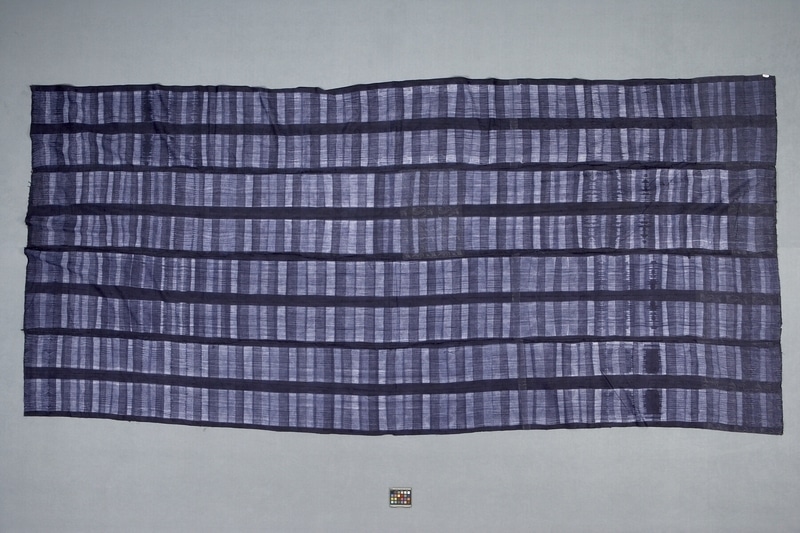Head Cloth Item Number: 831/2 a from the MOA: University of British Columbia


Description
Head cloth composed of four long strips of leaf-patterned damask fabric sewn together to form a rectangle. The fabric is dyed with bands of lighter and darker purple bands and long thin lines of light purple run perpendicular to these. These bands alternate with thinner bands of dark purple, and the ends are unfinished.
History Of Use
Indigo head scarves are a type of cloth found among the Wolof people of northern Senegal, known as “musooru cuub”. From the 19th century, the European transatlantic slave trade and French colonization of the region introduced indigo-dyed cotton cloths imported from India. Known as “guinées”, indigo dye was said to protect from sun rays, repel mosquitoes and represented a sign of prosperity. It became an influential exchange currency in the acacia gum trade along the Senegal River, particularly through the port city of Ndar (or Saint Louis). Today, stitched resist indigo-dyed cloth is used as clothing, for head scarves but also shawls and pagnes (loincloths).
Specific Techniques
Before dyeing the cloth in indigo, narrow strips are cut up for patterning and later cut away with a sharp blade so as to leave designs on a blue background. One common method is to stitch the cloth so that it compresses and withstands the dye, preventing the dye from reaching the cloth. Raphia threads are also used to prevent the cloth from breaking when tightened after dyeing.
Item History
- Made in San Louis, Senegal
- Collected during 1980
- Owned by Virginia Leeming before October 21, 1982
- Received from Virginia Leeming (Seller) and Unknown (Funding source) on October 21, 1982
What
- Name
- Head Cloth
- Identification Number
- 831/2 a
- Type of Item
- cloth
- Material
- cotton fibre ? and dye
- Overall
- height 303.0 cm, width 130.0 cm
Who
- Culture
- West African
- Previous Owner
- Virginia Leeming
- Received from
- Virginia Leeming (Seller) and Unknown (Funding source)
Where
- Holding Institution
- MOA: University of British Columbia
- Made in
- San Louis, Senegal
When
- Collection Date
- during 1980
- Ownership Date
- before October 21, 1982
- Acquisition Date
- on October 21, 1982
Other
- Item Classes
- textiles
- Condition
- good
- Accession Number
- 0831/0002 a